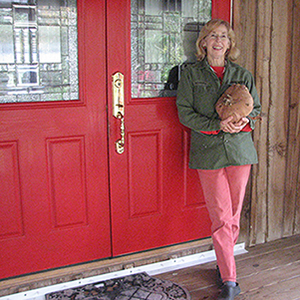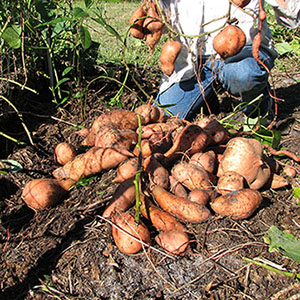In The Garden: Revisiting Sweet Potatoes
- Sweet Potatoes Grow Easily In Hot Sandy Soil
- Summer Sweet Potatoes Harvest In October
I was reviewing my article In The Garden: Growing Sweet Potatoes, and I see it is time for an update. It has been a few years since my first crop of sweet potatoes. I have learned a bit more about them and I have distributed them to growers and gardens far and wide.. I love them more now than ever before, and in Revisiting Sweet Potatoes I think you will discover why you will too.
Sweet potatoes quickly grew out of the mounds in my garden, through the fence and into the hot dry sand outside of my garden where they made the hardest, largest, unblemished, super sweet, sweet potatoes I have grown. The plants inside the mounds of the garden were in dark moist fertile soil and there they often became fodder for the invertebrates of the soil. Sweet potatoes love to grow in hot dry sand.
I harvested as many sweet potatoes as I could find in the garden using just my hands (no tools), and I threw the vines down on the ground outside of the garden. I planted my winter crops there where the sweet potatoes had been. When the winter crops were winding down and beginning to succumb to the longer hotter days sweet potatoes began to send up sprouts. Obviously I missed some potatoes when I harvested them in the fall. This has happened every spring since I began growing sweet potatoes. Here in the south, or zone 9b sweet potatoes can be considered perennials, and while they will absolutely engulf a garden area in the summer, they are likely to be dormant or at least slow growing in the winter, yielding the garden to other crops.
Even though the sweet potatoes don’t make great yields in my rich garden soil I let them come up and fill those beds because they cover the soil all summer long, and because they become fodder for the invertebrates in the soil. Sweet potatoes make an excellent summer cover crop protecting soil from sun feeding soil organisms and making it difficult for wild plants to grow there. When I take them out in the fall the soil where they grew is ready for the next crop.
Sweet potato greens are good food. I can feed vines and leaves to my chickens and rabbits, and I can eat the leaves in my stir fry.
We grew sweet potatoes in mounds at Heathcote’s No Till Organic Garden, and we grew them along the outside of our gardens in the unimproved, unwatered soil using just some leaf mulch over them. Like in my garden at home the mounds did not produce good or numerous sweet potatoes whereas the hot dry sandy soil at the edges of the garden produced huge yields of large, unblemished sweet potatoes. Mostly they were in groups of three and we only had to push the leaf mulch aside to find them pushing out of the soil’s surface. Where we harvested the sweet potatoes the ground was soft and pliable but as soon as we moved past where they grew the soil was compacted and unyielding. Sweet potatoes naturally soften soil making it ready for the next crop.
Sweet potatoes store well once cured. It is easy to get large yields of sweet potatoes in unirrigated, unimproved sandy soil so you can have lots of them to store, to share, and to feed to pets and livestock. Sweet potatoes are a staple crop that is easy to grow.
To increase your sweet potato yields: when the vines begin to sprawl make cuttings and plant them several inches deep where there are bare spots. I have also found they very much appreciate a light leaf litter mulch.
Because it is easy to grow, because of it’s perennial nature, because it’s roots and leaves can be eaten, and because it makes a good ground cover crop the sweet potato is a permaculture crop.
While there are many different colors of sweet potatoes my favorite is still the orange flesh variety. For its sweet flavor and it’s appealing orange hue.



6 Responses
I was happy to see that you also mentioned that you can eat the leaves. For me, sweet potatoes are one of my main summer crops, not so much for the roots as much as for the leaves. I find them tastier than spinach, and FAR easier to grow here in 9b.
I grew up in WV, so learning seasons and what to grow in each has been quite the journey, and I know it is far from over 🙂
Thanks for the article!
db
Thanks for the camment db. I am glad to hear from other 9b gardeners.
Adina, you spelled comment wrong in the above response. But you only tell the truth.
Thanks for keeping me on the straight and narrow GPC.
I made a lazy version of this last night that was a hit with the whole fmilay. I peeled and sliced the sweet potatoes and tossed them in a bowl with the melted butter and olive oil. Then I dipped the tops into a smaller bowl with the blend spices. I had to brush some of the mixture off to it wasn’t too thick, but then I placed them spice-up on the cookie sheet and baked them until they were done. Not as pretty as yours, but DELICIOUS! It was a trial-run for our mini-Thanksgiving tomorrow, with just my immediate fmilay, when we’re doing a lot of the traditional Thanksgiving foods but with a twist. I know everybody will love them. Thanks for the great recipe!(PS: Doing it my lazy way did mean that the parchment stayed very clean and we had no issues with smoking or burning sugars. In fact we did have a little spiced candy drips on the paper that was fun to eat before I got started washing dishes.)
Okay, thanks for the comment on Sweet Potatoes. I didn’t post a recipe, so I’m glad you tried your own. Sounds delicious!